

phyti
-
Posts
212 -
Joined
-
Last visited
Content Type
Profiles
Forums
Events
Posts posted by phyti
-
-
KJW;
You introduced the binary tree and I'm saying that I'm not going to accept any arguments from you involving the binary tree, and why.
Show me the beginning of a sequence that is not in the binary tree.
0 -
KJW;
Quote1.
The infinite binary tree is actually ambiguous. It can represent all possible sequences of 0 and 1, or it can represent all possible finite sequences of 0 and 1, which is still infinite. The latter can actually be made into a list. The former cannot be made into a list. Your argument becomes invalid if you assume the binary tree represents all possible sequences of 0 and 1 but treat it like it represents all possible finite sequences of 0 and 1.
1.
You are reading things into my post that aren't there!
This follows fig.2. "Each s has no last v and L has no last row."
The ellipsis (...) means continue forever. It's an 'infinite' list.
Any continuous path in the tree represents a sequence.
Fig.3 shows the property of symmetry which means both D and E0 are present in L which represents M. There is nothing to prove as Cantor presents his list, before he defines b in his paper.
2.
For every Cantor (v), there are 2v sequences in a finite list. Since v is an integer from the set N, there is no largest v. Thus the set of all finite sequences cannot be listed. The list has no end. It's simple.
3.
I am NOT questioning Cantor's theorem. The subject is the 'diagonal argument'.
4.
The general population depends on the knowledge and experience of a few who specialize in various fields, doctors, lawyers, politicians, science, etc. for their 'expert' guidance. Those who accept a theory will typically know less about it than the author.
The patient trusts the treatment prescribed by their doctor. The viewer doesn't have to know how tv communication works to get the benefits, or internal combustion for the ability to travel. Before 1670 people believed light moved instantaneously since that's what science believed. Then theory was revised to define light motion with a finite speed.
5.
Are these people in error because they disagree with Cantor?
Brouwer, Leopold Kronecker, Poincaré, Gauss, Wittgenstein
If Cantor's theory is in error, it's his error, it's his idea/mental construct.
Bertrand Russell, Mayberry (2000, p.10) has noted that "The set-theoretical axioms that sustain modern mathematics are self-evident in differing degrees. One of them – indeed, the most important of them, namely Cantor's axiom, the so-called axiom of infinity – has scarcely any claim to self-evidence at all".
Weyl
classical logic was abstracted from the mathematics of finite sets and their subsets …. Forgetful of this limited origin, one afterwards mistook that logic for something above and prior to all mathematics, and
Quote2.
But earlier in this thread, I showed that the set of all finite sequences can be listed. I then applied the diagonal argument to this list to obtain an E0 that is excluded from the list. However, in this case the E0 obtained was also not a finite sequence, and therefore a proof using the diagonal argument that the set of all finite sequences cannot be listed fails.
3.
One can prove Cantor's theorem using sets, and the mappings between their elements and their subsets. So, if you're focusing specifically on sequences, then that won't invalidate proofs based on alternative notions.
4.
If there was an error in Cantor's proof, then the error isn't just Cantor's, it's all the people who have accepted Cantor's proof as valid, including myself. So, you have to do better than mention Cantor's fallibility. What about the fallibility of everyone else who accepted Cantor's proof?
5.
The validity of a mathematical theorem is self-evident, not based on the author.
finally applied it, without justification, to the mathematics of infinite sets. This is the Fall and original sin of [Cantor's] set theory …."
(Weyl, 1946)_________________
"You fail to recognise that there are sequences in the set of sequences that are not in the list of sequences. By failing to recognise this, you are unable to understand Cantor's proof because this is precisely what Cantor is proving."
Do you think repeating this multiple times will make it true?
Cantor fails to prove his idea via the diagonal argument with badly executed manipulation of the list. You don't like the conclusion which is; humans can't comprehend 'infinity'.
0 -
KJW;
1.
You think I contradicted myself, don't you?
2.
That's because you fail to distinguish between the set of sequences and the list of sequences. You fail to recognise that there are sequences in the set of sequences that are not in the list of sequences. By failing to recognise this, you are unable to understand Cantor's proof because this is precisely what Cantor is proving. By assuming that the list of sequences has all the sequences that are in the set of sequences and using this assumption in an attempt to disprove Cantor's theorem, you are begging the question.
3.
By "the list is incomplete", I mean that there are sequences in the set that are not in the list, and that is precisely what Cantor is proving. Having "no last member" doesn't come into it. But by assuming that there is only one infinite, you are assuming that Cantor's theorem is false in your attempt to disprove Cantor's theorem, again begging the question.
1. More like, make up your mind, which is it.
2. As a model the binary tree contains all possible sequences of 0 and 1.
Cantor knows, by defining a diagonal sequence D, and forming its negation E0 as a horizontal sequence, the E0 is excluded from the set.
It's another flaw in his manipulation of the list.
The horizontal sequence has coordinates (u, v) where u is a constant, and v varies from 1 upward through N.
The diagonal sequence has coordinates (u, v) where both u and v vary from 1 upward through N.
The first is one dimensional, the second is two dimensional.
He uses two different definitions of a sequence. If his math was as rigorous as you think, E0 would have inherited the properties of D and also be a diagonal.
3. The definition of 'infinite' literally means 'without end', thus it IS a factor.
Two different members of the set N can be compared to determine the greater of the two. No member of the set N can be compared to determine the greatest of the set. No matter how many members added to a collection, N has a corresponding n that expresses 'how many'. N is inexhaustible. There are no superlative degree of infinity. When the container is empty, it can't get emptier.
If you think Cantor was infallible, he admits to occasionally making mistakes.
You also claimed 'the man', or 'motive' is irrelevant.
A person is what they think. The more you know about the person, helps to understand their ideas, and helps to dispel false claims about them or their work.
0 -
KJW;
QuoteIn your paper, you said that L is a binary tree graph that represents the Cantor set M. Then yes, E0 must be a member of L. That is actually a part of Cantor's proof. But it is not what the diagonal argument is about. It seems to me that you don't really understand what it is that Cantor is proving. The sequence formed by negation of the diagonal is an element of the set of all the possible sequences (it is represented in the binary tree graph).
[Here you agree E0 is a member of L, which represents M.]
This is actually important to Cantor's proof and is why the negation of the diagonal is made of the same symbols as the sequences. When the sequences are placed into a list, the diagonal argument shows that although the negation of the diagonal belongs to the set of sequences, it does not belong to the list of sequences. Thus, the list of sequences is incomplete, proving that the set of sequences has a higher transfinite cardinality than the list of sequences, which has a transfinite cardinality of ℵ0. You appear to fail to distinguish between the set of sequences and the list of sequences, which is what Cantor's proof is about.
[Here you say E0 is not a member of L, which represents M. ?]
[Cantor doesn't have to prove the list is incomplete. Since the set M has no last member by definition of 'infinite', neither does the list L.]
[The binary tree shows both D as a member of Mo and E0 as a member of M1, thus they can't coexist in the same subset, but are still members of M and L. There is no other place for them. Why did Cantor the mathematician ignore this? (because it served his purpose?)
The diagonal D is similar to the original sequences, being a string of 0's and 1's, but
1. it is redundant since it is already in the binary tree as a horizontal sequence,
2. its definition required the list to be complete,
3. there are no diagonal sequences.]
KJW;
In your paper, you said that L is a binary tree graph that represents the Cantor set M. Then yes, E0 must be a member of L. That is actually a part of Cantor's proof. But it is not what the diagonal argument is about. It seems to me that you don't really understand what it is that Cantor is proving. The sequence formed by negation of the diagonal is an element of the set of all the possible sequences (it is represented in the binary tree graph).
[Here you agree E0 is a member of L, which represents M.]
This is actually important to Cantor's proof and is why the negation of the diagonal is made of the same symbols as the sequences. When the sequences are placed into a list, the diagonal argument shows that although the negation of the diagonal belongs to the set of sequences, it does not belong to the list of sequences. Thus, the list of sequences is incomplete, proving that the set of sequences has a higher transfinite cardinality than the list of sequences, which has a transfinite cardinality of ℵ0. You appear to fail to distinguish between the set of sequences and the list of sequences, which is what Cantor's proof is about.
[Here you say E0 is not a member of L, which represents M. ?]
[Cantor doesn't have to prove the list is incomplete. Since the set M has no last member by definition of 'infinite', neither does the list L.]
[The binary tree shows both D as a member of Mo and E0 as a member of M1, thus they can't coexist in the same subset, but are still members of M and L. There is no other place for them. Why did Cantor the mathematician ignore this? (because it served his purpose?)
The diagonal D is similar to the original sequences, being a string of 0's and 1's, but
1. it is redundant since it is already in the binary tree as a horizontal sequence,
2. its definition required the list to be complete,
3. there are no diagonal sequences.]
0 -
Look again at the binary tree.
There are no diagonal sequences. All are horizontal, as originally shown by Cantor.
The diagonal is his misdirection.
0 -
KJW;
"Per the constructivist view, no one can nor have formed an infinite list.
No one can even form an infinite sequence!"Anyone can define an infinite list.
No one can produce one.
Do you understand the difference?
It seems to me that you are placing too much importance on the structure of the list of sequences while not placing enough importance on what the diagonal argument is saying.
If that's what you think, then here is another version that doesn't consider the form of an infinite list.
KJW;
Something went wrong!
"Per the constructivist view, no one can nor have formed an infinite list.
No one can even form an infinite sequence!"Anyone can define an infinite list.
No one can produce one.
Do you understand the difference?
It seems to me that you are placing too much importance on the structure of the list of sequences while not placing enough importance on what the diagonal argument is saying.If that's what you think, then here is another version that doesn't consider the form of an infinite list.
0 -
KJW;
[/quote]
Where did you get the idea that the sequences are random? The more correct term is "arbitrary", which is not the same as "random". In fact, Cantor attempts to construct an infinite list of all possible infinite sequences. But regardless of how that is attempted (represented by a list of arbitrary sequences), the list will always be missing the sequence constructed from the negation of the diagonal.[/quote]'Arbitrary' and 'random' are synonyms for each other.
1. Before he defines b, all s(equences) are horizontal, there are no diagonal s.
2. He defines D from the list as all the elements with coordinates (u, u).
3. If he forms the negation of D as E0 and states it's missing from the list, he contradicts himself, since he has assumed D is a member of the list. The building set is binary {m, w}, they occur in pairs! If D then E0.
0 -
On 1/9/2024 at 12:14 AM, Dhamnekar Win,odd said:
Author's answer to first case is π4 Do you disagree with that? Author assumed R be the radius of big circle, rn be the radius in the outer layer of the big circle and r^n be the radius of next inner layer circle of the big circle and Rn be the radius of the concentric circles inside the big circle. Following are the concentric circles.
 Do you agree with this author's assumption? Author computed the first case answer considering all these assumption.
Do you agree with this author's assumption? Author computed the first case answer considering all these assumption.
I think the following question with answer will be considered for more reference.
Win_odd Dhamnekar (https://math.stackexchange.com/users/153118/win-odd-dhamnekar), Inscribed circles inside an equilateral triangle, URL (version: 2023-07-14): https://math.stackexchange.com/q/4735973
As Rn approaches R, rn approaches 0.
When Rn equals R, rn equals 0.
Why doesn't P=outer band/area of circle=0?
0 -
swansont;
Source: me, who worked for ~25 years at the US Naval Observatory in the precise time department
And NIST provides the time standard for anyone who needs it.
A process that measures 9 billion+ microwave cycles to define the second.
I.e. the standard is man-made, a convention. Not an independent entity like an em or gravitational field, or a particle.
From birth to death, you have a paper trail, all timestamped.
No one has time in a bottle.
0 -
KJW;
But you have not shown that Cantor's diagonal argument is false.
The flaw is his definition of a diagonal sequence/string/s. It depends on all s listed, and differs from those. He defines the initial list as consisting of horizontal s. That's why the random properties of the s and the list which is itself a random s are included. If the s are parallel there can't be any influence of one on any other. I.e. they are independent.
All you have done is denied the existence of infinite lists and infinite sequences.False. I use the infinite set N. I haven't seen an answer to 'what is the magic n when the split occurs' that he describes in excerpt 2 below.
And you are incorrectly applying Cantor's diagonal argument to finite lists of finite sequences.
Those are the only ones we can form. No one has or can produce an infinite list.
It's not an abstraction but a fantasy. No one will ever see a list for the set N.
excerpts from 'Cantor on Set Theory':
1.
"This correlation, if it is possible at all, is, as one easily sees, always completely determinate; and since in the widened number sequence there is always one and only one number alpha such that the numbers preceding it (from 1 on) on the natural succession have the same Anzahl, one must set the "Anzahl" of both these "well-ordered" sets directly to alpha, if alpha is an infinitely large number, and to the number alpha-1 which immediately precedes alpha, if alpha is a finite integer."2.
"When I conceive the infinite … there follows for me a genuine pleasure … in seeing how the concept of integer [der ganze Zahlbegriff], which in the finite has only the background of number [Anzahl], as it were splits into *two* concepts when we ascend to the infinite"He rambles on about determinate order/well ordered. How can there be an ordered set/list for an infinite set? Using {0, 1} in that succession:
1. (000000...),
2. (000000... where/when do we put the first 1?
If you have two identical s that only differ in the last symbol, you can't sort them, since there is no last symbol. Thus most if not all mathematical operations that are defined for finite (things with boundaries) can't be applied to things without boundaries, including measurement (counting).
But that is what Cantor is trying to do.
The meaningless phrase in red is more of the nonsense cited by Wittgenstein.
0 -
What is time?
The operational definition of assigning a time to an event as mentioned by A. Einstein in his 1905 paper is essentially what it is, and how it's been done since humans appeared.
It is a correspondence convention, i.e., assigning events of interest to standard clock events, a measure and ordering of activity, with 'time' always increasing/accumulating.
It is an accounting scheme developed out of practical necessity, for human activities like agriculture, business, travel, science, etc. The unit of measure for time initially referred to relative positions of astronomical objects, stars, sun, and moon, which implies earth rotations and earth orbits. All units of time are by definition, involving spatial motion or distance. The clock further divides the day into smaller units of measure. Current scientific research requires clocks that generate smaller and more precise periods than those of the past. The second is defined as n wave lengths of a specific frequency of light, a distance, but labeled as "time".
If we use a light based clock to time the speed of an object along a known distance x, what are we actually doing?
We are comparing the simultaneous motion of an object to the motion of light for a duration (number of cycles). The result is a ratio x/s = vt/ct = v/c or speed. It should be obvious that the number of cycles serves to correlate the positions of the object with the positions of the light signal, for simultaneous comparisons. If you use Minkowski spacetime diagrams the vertical scale is not 'time', but ct, light path distance, i.e. they plot speed. This allows a simple comparison of equivalent entities, without consideration of the nature of those entities. The scaling of the time variable by c allows an analysis of extremely short durations of time.
quotes by the author of SRFrom 'The Meaning of Relativity', Albert Einstein, 1956:
page 1.
"The experiences of an individual appear to us arranged in a series of events; in this series the single events which we remember appear to be ordered according to the criteria of "earlier" and "later", which cannot be analyzed further. There exists, therefore, for the individual, an I-time, or subjective time."
page 31.
"The non-divisibility of the four-dimensional continuum of events does not at all, however, involve the equivalence of the space coordinates with the time coordinate."
page 32.
"Finally, with Minkowski, we introduce in place of the real time co-ordinate l=ct, the imaginary time co-ordinate..."
[This does not mean 'time' is literally imaginary. The 'i' in the complex plain indicates a coordinate independent of the others, when (x, y, z) are present.]time and perception
Subjective time requires memory, which allows a comparison of a current state to a previous state for any changes, which lends itself to an interpretation of time flowing.Patients with brain damage to specific areas involved in maintaining a personal chronology, lose their ability to estimate elapsed time, short or long term. Consider the fact that people waking from a comatose state, have no memory of how much elapsed time, whether hrs, days, or even years.Consider one of the greatest misnomers ever used, 'motion pictures' or 'movies', where a person observes a sequence of still photos and the mind melds them to produce moving objects where there is no motion. These cases show time as part of perception. Special Relativity then predicts alteration of measurement and perception via motion.
misc.
It was Minkowski who advocated the mathematical manipulation of the expression for the invariant interval from an equality to a generalized form of four variables, producing spacetime. I refer to the Minkowski version of SR as a 'lines on paper' theory. Time is represented as a line, removing any attributes that would distinguish its identity from other variables, a line is a line.
Math equations that express a behavior as a function of time, are misleading when the time is interpreted as a causative factor. The time of an event must be assigned after the event occurs, i.e. after awareness! If a nova is observed in 2010, and is 100 ly distant, it didn't happen because it was 1910 on earth. It was the physical processes already in place that reacted to an unstable state. A person dies, not because it's his 'time', but because his biological system reaches a state that can't be maintained.Which brings us to the real issue (for me) perpetuating the millenia of debating 'time'.
No one wants to be informed "atomic clock at NIST has a hole in it and time is running out". Time implies longevity. People gain some sense of security if they think there is an invisible entity behind the scenes arranging and scheduling more events.
Time is not an issue for physics but for psychology.Source: 15 years participating in forum debates, and Scientific American, 'A Matter of Time', vol. 287, 2002.
0 -
-
Per the constructivist view, no one can nor have formed an infinite list.
No one can even form an infinite sequence!
The 'infinite list' is a contradiction of terms. If it has no last element, it would always exist in an incomplete state. You ignore the fact that the rule of formation determines the geometric form of the list, not the word 'infinite'.
If Cantor' diagonal argument is false, his followers would miss their 'feel good moments', believing they can comprehend deep things.
He would have had better credibility by descending from a high place with a stone tablet with aleph0 etched on it.
0 -
-
Another frustration of the internet system! They offer 'file sharing' which should work without being a subscriber!
Here is the pdf (many viewers don't have MS os).
0 -
In case there is anyone else interested in the subject of Cantor's diagonal argument,
the latest paper is here:
https://drive.google.com/file/d/17Zz39YzAEEvD5pWB0f4NihEucQfZ3RHU/view?usp=sharing
0 -
Dehamnekar:
The author made the problem more complicated than necessary. No need to count the circles in the outer band.
Let B=area of outer circle and A= area of inner circle.
The ratio P =(B-A)/B. The limit of A=B, thus P=0/B.
0 -
KJW;
You still don't understand, my argument with Cantor's argument doesn't involve properties of numbers. As he states in the 1891 paper "However, there is a proof of this proposition that is much simpler, and which does not depend on considering the irrational numbers."
It involves two alphabetical symbols used in forming sequences/patterns as members of a set M. The elements are sequences, NOT numbers. The integers in the set N are used for the purpose of forming an array within a coordinate system (v, u). L His goal is to convince the reader that the list will be incomplete. Thus the cardinality (number of elements in a set) L is greater than N. This allows him to sell his transfinite numbers.
I will leave you with your math diversions.
0 -
KJW;
fig.1 shows the alternating series s=(1-2+3-4+5-6+7-8...) as a discontinuous function.
fig.2 shows continuous functions A and B.
For A y=x.
For B y=-x.
If A and B are applied to fig.1, the difference A-B=0 for all x.
The B function has been shifted by -1 in fig.2.
The equation for B is transformed from y=-x to y=-x-1.
Now the difference A-B=x-(x+1)=(-1) for all x.
The shift results in subtracting the B value for x from the A value for x-1.
0 -
35 minutes ago, KJW said:
Did you continue to read what I said after "The term "approaching infinity" is often used in connection to limits."? You seem to have put in a lot of effort to argue against a phrase that is intended to be intuitive. Why can't you approach something that is out of reach? The notion of limits is about approaching something but not actually reaching it.
You answered your question in the last line!
The anaut can't get any closer to the horizon.
The horse keeps moving forward to reach the carrot on a stick but never reaches it. Infinity can appear in cases other than math.
KJW;
Ref. '1+2+3+4+', Wiki.
The partial sums are discrete integers. There are no bands of areas forming a step function as shown in the Wiki article. The green curve appears to be enclosing an equivalent area of the bands. No reason for y to be <0 when x=0.
Ref. png graphic:
Using y=x(x+1)/2 the green curve contains the partial sums for all n.
The y increment remains increasing without limit, thus no last term.
alternating series s=(1-1+1-1+1...)
1. For self referential, s-1= -s, thus s=1/2 avg .
2. If summed sequentially, s=0 or 1, with an avg. of 1/2.
3. If sorted and summed, s=(n-n) = 0, or
s=[(1-1)+ (1-1)+ (1-1)+ (1-1)...] = 0.
Depends on the method of manipulation.
alternating series s=(1-2+3-4+5-6+7-8...)
s=(1+3+5+7...)-(2+4+6+8...)=A-B
s=Σ(2x-1)-2Σ(x), x varies 1 to n.
s= 2Σ(x)-n-2Σ(x)=-n.
Ref. png graphic
The measurements are alternating which skews the differences. Using the envelope measurements which are linear, and B' is the mirror image of B, the difference is .5.
0 -
-
KJW;
Have you ever seen the following identity?:
Yes, and not impressed. It's confusing since the initial question is the value for the summation of the elements of N. It's a series of discrete values, not continuous. The equation resulting in -1/12 looks like nonsense, not an equality at face value. This quote from the Wiki page:
"Because the sequence of partial sums fails to converge to a finite limit, the series does not have a sum".
Why would anyone expect a limit for a positively divergent series?
The value is ℵ0. Why do you think its value should be something else?
Already covered this. ℵ0 is a symbol representing a number.
'c' represents the speed of light. It's a convention to avoid writing its value (3*108) each time it is used. Cantor had no value to assign to ℵ0 because there is no way of counting/measuring a set that has no limit.
That the union of two disjoint sets, both of which have a cardinality of ℵ0, has a cardinality of ℵ0 is logical because we are not dealing with finite sets.
[/quote]
N {1 2 3 4 5...}
E {2 4 6 8 10...}
D {3 5 7 9 11...}
Looks more like a 1 to 2 correspondence, each n to a pair.
Where have I said that it does? I think I have indicated that "infinite" is a property.
Didn't say you did. I'm referring to Cantor's ideas.
0 -
KJW;
[quote
Earlier in this thread, you indicated that there is only one infinity. Have you changed your mind on that?
[/quote]
No. 'Infinite' has no superlative state. Comparison of 2 quantities results in equal or not equal. If not equal, one is greater than the other. For a sample size >2, if one is greater than all others in a sample s, then it is the greatest relative to s.
Cantor quote:
"When I conceive the infinite … there follows for me a genuine pleasure … in seeing how the concept of integer [der ganze Zahlbegriff], which in the finite has only the background of number [Anzahl], as it were splits into *two* concepts when we ascend to the infinite – one one of number [Anzahl] which is necessarily bound to a lawlike ordering of the set [Menge] by virtue of which it becomes well-ordered (wohlgeordneten)."
So again I ask, what is the magic n in N which is infinite by definition, where the set becomes aleph0?
Cantor's error is assuming the diagonal D extends to the end of the list forming a geometric square, excluding its negation E0. That's not possible using established math procedures plotting the relation between u and v.
The variable v is a linear function, the variable u is an exponential function. They are never equal as shown in the graph. The (u, v) relation depends on the number of symbols used in the formation of sequences.
--------------------------------------------------------
I can't imagine 'approaching infinity', yet it's a common phrase in most text books.
Do you know how?
[ref]
'Cantor on Set Theory',Source: Ewald, W., From Kant to Hilbert, Oxford 1996.0 -
KJW;
1.
The fact of the matter is that the validity of a mathematical theorem is independent of who originated it or how it is expressed in particular writings.
2.
I don't know about that. It turns out that the mapping from the group of integers Z ...
3.
Leopold Kronecker was a subscriber to the philosophy of finitism and was thus in the minority among mathematicians.
4.
I am a subscriber to the philosophy of formalism, and regard mathematics as not being rigorous unless it can be derived from first principles (axioms) by mechanical symbol manipulation.
5.
The cardinality is aleph0.
1. It concerns the motivation of the author. There have been real world cases of scientists who manipulate data to support their theories. In the justice system, motive is important.
2. It's NOT about mapping of any class of numbers. It's Cantor's use of the diagonal argument to prove a list of generic symbols is incomplete.
"However, there is a proof of this proposition that is much simpler, and which does not depend on considering the irrational numbers".
3. On another forum someone thought the solution to a different subject involved classifying me in a particular belief system. He was eventually banned, and at that point I wished I had told him I was a librarian.
4. I would have to side with the constructivist.
5. What is it's value? Is it the largest number you can think of?
Infinite implies without a boundary/limit. It does not imply a largest number.
Measurement in a world of finite things is based on boundaries, and why the rod with one end. Apply the hook end of your industrial strength tape measure to the near end, extend it until the far end is aligned to a mark on the tape. But you reply, 'there is no end'. The event 'reaching the far end' never happens!
0

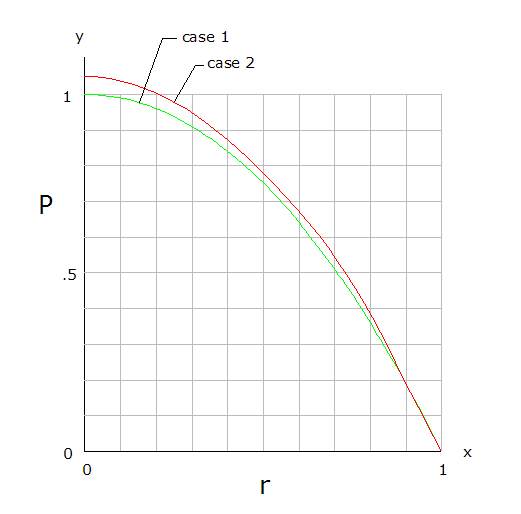
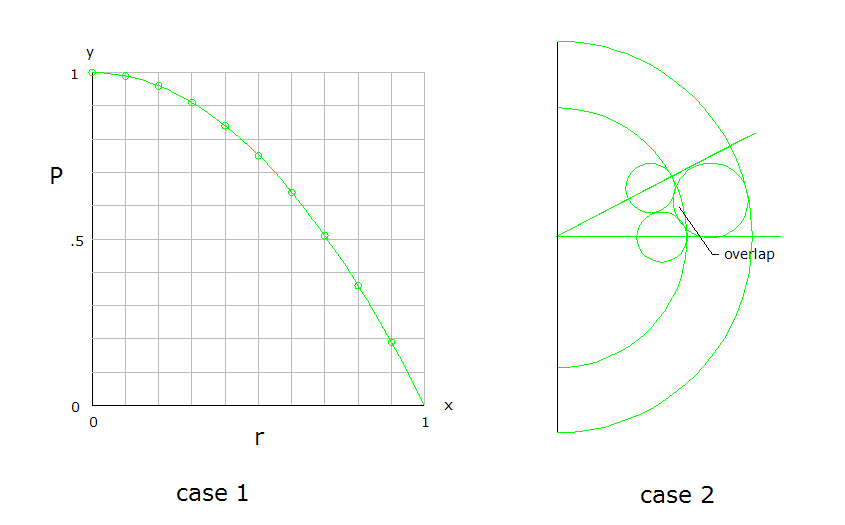

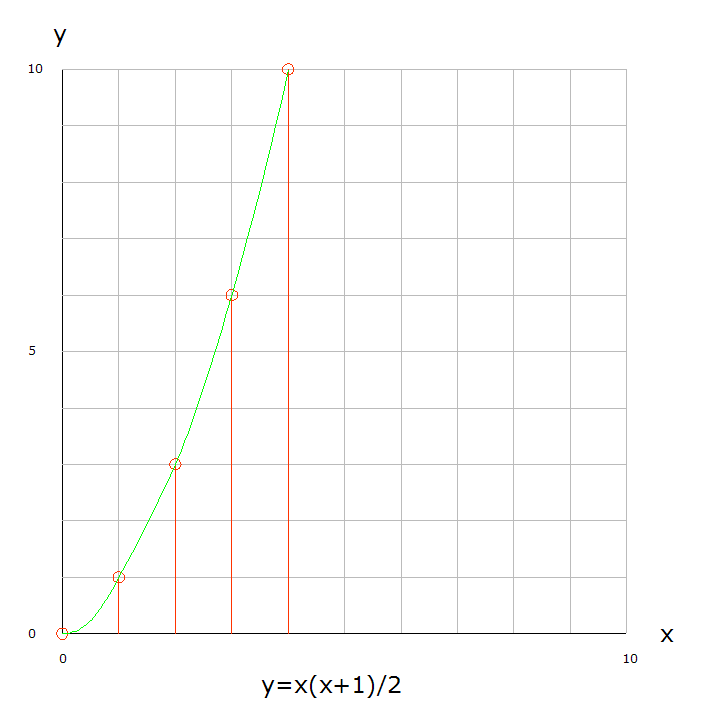
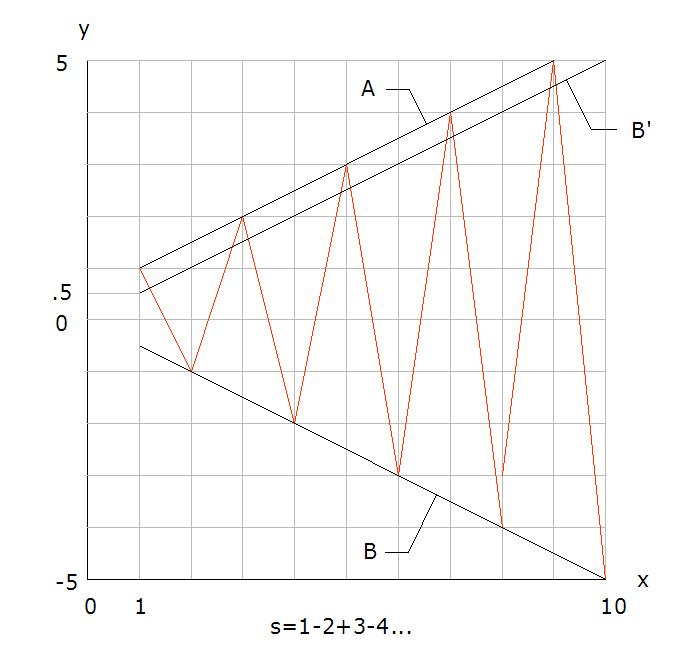
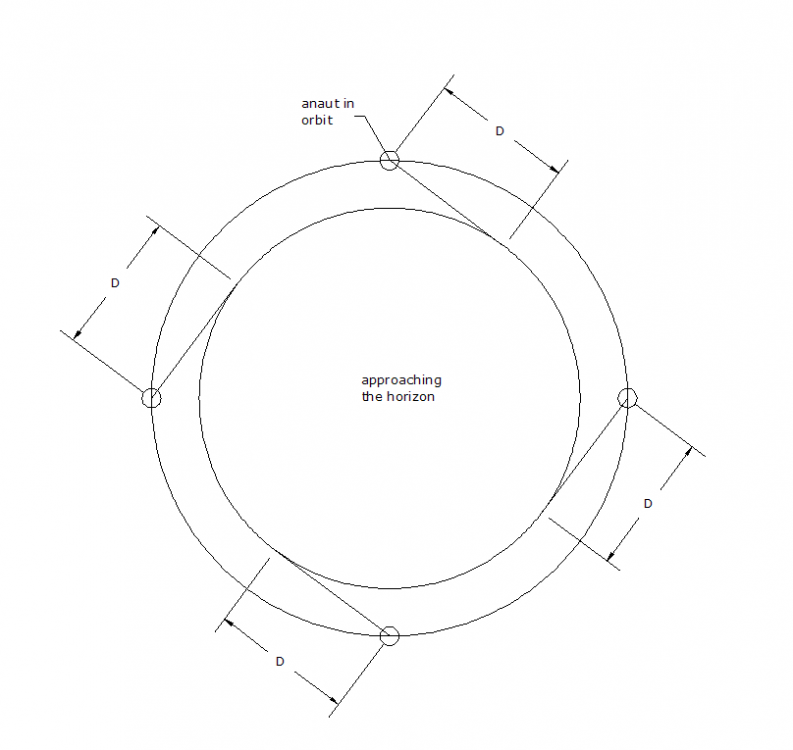
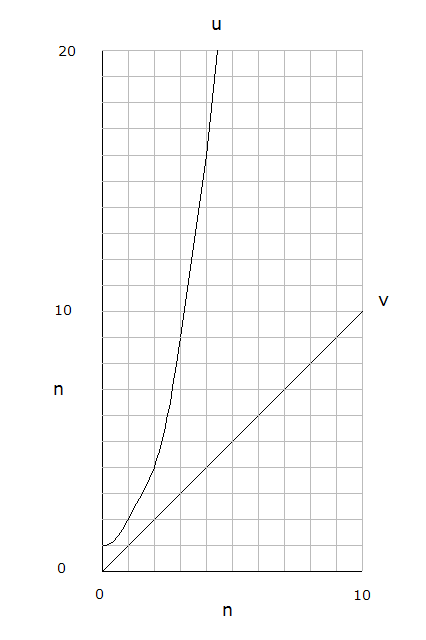
Concerning Infinity (of course)
in Linear Algebra and Group Theory
Posted
Boltzmannbrain;
s=Σ (1/2n), for n=1 to ∞
s is a series of partial sums, a variable and a geometric progression for this example.
The sum s will converge toward a limit.
The limit of s is a constant c=1, also denoted as an asymptote.
s approaches c, but by definition of 'infinite' (without limit/last term),
never equals s.
s=(1/2+1/4+1/8+...+1/2n)
for n terms.
2s-1=(1/2+1/4+1/8+...+1/2n-1)=s-1/2n
for n terms.
s=1-1/2n
1/2n>0 for all n.
For large values of n, 1/2n is judged insignificant for the purpose
and the limit is used to represent the value of s.
This would also apply to the series .999R converging to its limit 1.